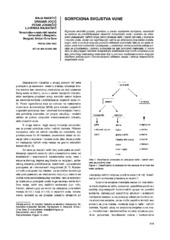Sorpciona svojstva vune
Sorption properties of wool
| dc.creator | Radetić, Maja | |
| dc.creator | Jocić, Dragan | |
| dc.creator | Jovančić, Petar | |
| dc.creator | Rajaković, Ljubinka V. | |
| dc.date.accessioned | 2021-03-10T10:17:10Z | |
| dc.date.available | 2021-03-10T10:17:10Z | |
| dc.date.issued | 2004 | |
| dc.identifier.issn | 0367-598X | |
| dc.identifier.uri | http://TechnoRep.tmf.bg.ac.rs/handle/123456789/687 | |
| dc.description.abstract | Rigorozni ekološki propisi, posebno u visoko razvijenim zemljama, nametnuli su zahteve za prečišćavanjem otpadnih industrijskih voda i potrebu za efikasnim uklanjanjem naftnih mrlja nakon izlivanja nafte i njenih derivata u kopnene i morske vode. Jedan od najefikasnijih načina za uklanjanje jona teških metala, boja i nafte iz vode je sorpcija pomoću efikasnih sorbenata. lako je do sada razvijen veliki broj sorbenata i postupaka, u poslednje vreme posebna pažnja pridaje se proučavanju i primeni sorbenata na bazi prirodnih materijala. U ovom radu je dat pregled rezultata dosadašnjih istraživanja sorpcionih svojstava vune kao prirodnog vlaknastog materijala koji u procesu multifunkcionalne sorpcije (fizičkom adsorpcijom i hemisorpcijom) efikasno vezuje i uklanja nespecifične zagađivače vode. | sr |
| dc.description.abstract | Strict ecological legislation, especially in highly developed countries, imposed requirements for the purification of industrial effluents and the need for efficient oil clean up after sea and inland water spills. Although numerous processes have been developed, the application of sorbents is still one of the most efficient methods to remove heavy metal ions, dyes and crude oil from water. Recently, special attention was paid to sorbents based on natural fibres. A review of studies concerning the sorption properties of wool is presented in this paper. The presence of various functional groups on the wool fibre surface contributes to the efficient sorption of heavy metal ions and dyes. A hydrophobic, scaly surface and fibre crimp strongly influence the high sorption capacity of wool for oil. Wool has great sorption potential even as a recycled material. Accordingly, it can be used as a viable substitute to commercially available synthetic sorbents that show poor biodegradab ility. | |
| dc.publisher | Savez hemijskih inženjera, Beograd | |
| dc.rights | openAccess | |
| dc.rights.uri | https://creativecommons.org/licenses/by-nc-nd/4.0/ | |
| dc.source | Hemijska industrija | |
| dc.subject | vuna | sr |
| dc.subject | sorbent | sr |
| dc.subject | joni metala | sr |
| dc.subject | ulje | sr |
| dc.subject | wool | |
| dc.subject | sorbent | |
| dc.subject | metal ion | |
| dc.subject | oil | |
| dc.title | Sorpciona svojstva vune | sr |
| dc.title | Sorption properties of wool | |
| dc.type | article | |
| dc.rights.license | BY-NC-ND | |
| dc.citation.epage | 321 | |
| dc.citation.issue | 7-8 | |
| dc.citation.other | 58(7-8): 315-321 | |
| dc.citation.spage | 315 | |
| dc.citation.volume | 58 | |
| dc.identifier.doi | 10.2298/HEMIND0408315R | |
| dc.identifier.fulltext | http://TechnoRep.tmf.bg.ac.rs/bitstream/id/8351/0367-598X0408315R.pdf | |
| dc.type.version | publishedVersion |

